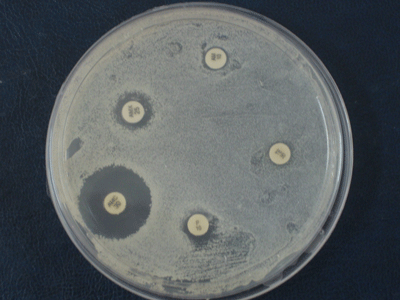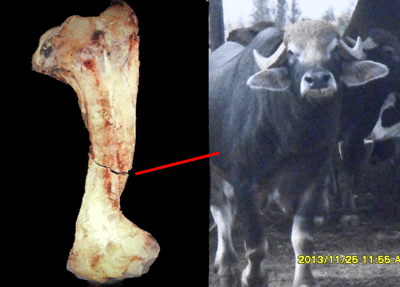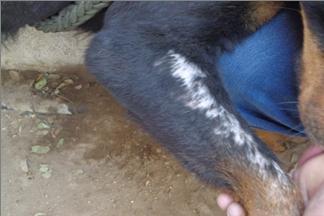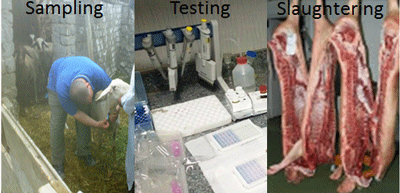Previous issue | Next issue | Archive
Volume 5 (4); December 25, 2015
 Research Paper
Research Paper
Antibiotic Resistance Profile of Coagulase Positive Staphylococcal infection in Dairy Buffaloe.
Ali AO, Mahmoud HYAH., Sameh A, Zaky S and Elsayed A.
World Vet. J. 5(4): 46-50, 2015; pii:S232245681500010-5
DOI: http://dx.doi.org/10.5455/wvj.20151055
ABSTRACT
For isolation and identification of the antibiotic resistance profile of Staphylococcal infection derived from buffalo (Bubalus bubalis) milk, a total of 100 milk samples have been collected from different villages in Qena governorate, Egypt, these animals were owned by small scale breeding farmers. S. aureus formed 23%, 58% other Staphylococci and other pathogens contained19% of the total number of samples. The S. aureus isolates have been tested for antibiotic susceptibility against 14 different widely used antibiotics, all S. aureus strains were resistant to Nalidixic acid by 100% and the lower percentage of resistance was to Ampicillin by 4.8%. The Multiple antibiotic resistances have been calculated for all S. aureus strains, the highest value was 1 and the least one was 0.143. The Buffaloe is considered one of the most important dairy animals in Egypt especially in the small scale breeding and the presence of S. aureus and other Staphylococci causing a great risk on the productive level of these animals due to mastitis as well as for the human beings, from here comes the importance of the detection of the antibiotic resistance profile.
Key words: S. aureus, Antibiotic susceptibility test, Mastitis
 Research Paper
Research Paper
Management of Poultry Farms and the Likelihood of Contamination of Poultry Feed with Mycotoxinsin Gharbia Governorate, Egypt.
Fahmy NE, Eltholth MM, Mohamed RA, ElTras WF, El-Midany SA.
World Vet. J. 5(4): 51-58, 2015; pii:S232245681500011-5
DOI: http://dx.doi.org/10.5455/wvj.20151056
ABSTRACT
The aim of this study was to characterize the poultry production system in Gharbia governorate and assessing the risk of contamination of poultry feed with mycotoxins. A total of 65 poultry farms were visited, in addition to interviewing owners and/or workers, poultry feed samples were collected. Feed samples were analysed for the detection of Total Aflatoxin (TA) and Ochratoxin A (OTA). The concentrations of TA and OTA were determined using direct competitive Enzyme-Linked Immunosorbent Assay. About 50% and 36% of farms were rearing ducks and broiler chickens, respectively. The number of birds per cycle was varied between less than 5,000 to more than 20,000. 58.5% of poultry farms reported having special designated area for dead poultry disposal and 77% of poultry farms used branded commercial feed. The mean length of storage of feed at the farm was five days and about 75% reported having a special poultry feed store. Almost all poultry farmers reported that, they have heard about mycotoxins and more than 80% used anti-mycotoxins as feed additives. All samples were contaminated with both Aflatoxins and Ochratoxins. The mean concentration of Aflatoxins in feed samples was 73.25 ppb, and 100% of samples were higher than the maximum permissible limit (20 ppb). The mean concentration of Ochratoxins in feed samples was 43.58 ppb, and 2.22% of samples were higher than the MPL (100 ppb). In conclusion, the hygienic conditions of the current poultry production system in Gharbia governorate were not optimum. This would increase the likelihood of disease transmission between poultry farms and the likelihood of contamination of poultry feed with mycotoxins. Breeder companies and poultry feed traders could play a role in raising the awareness of poultry producers with the importance of hygiene and biosecurity. Further studies for the economic impacts of mycotoxins on poultry production are required.
Key words: Poultry Farms, Aflatoxins, Ochratoxins, Feed Stores, Hygiene, Management
 Research Paper
Research Paper
Humeral Fracture in Heavy Pregnant Buffaloes; an Overview.
Sharshar AM, Aly MA, Shoghy KM, Abedellaah BA, Rashed RF, Gadallah SM.
World Vet. J. 5(4): 59-65, 2015; pii:S232245681500012-5
DOI: http://dx.doi.org/10.5455/wvj.20151057
ABSTRACT
The purpose of this study was to highlight the possible causes of humeral fracture in mature pregnant buffalos at late gestation, in order to reduce its economic losses caused by slaughtering of the animal with the subsequent loss of the offspring and milk production. This study was performed over 3 years. Anatomical characteristics of the right and left humerus of mature buffalos were evaluated in fifty specimens (right and left of the same animals) using gross and radiological examinations (X-rays and CT). Biochemical analysis of blood serum samples collected from 45 mature female Egyptian buffalos was performed using the spectrophotometric method. The result of the present study indicated that humeral fracture (especially) in pregnant Egyptian buffalos during the last period of gestation have anatomic and metabolic factors, which interact and attribute to render the bone liable to fracture with minimum amount of stress. During this critical period, the heavy pregnant buffalos female requires careful management and handling.
Key words: Fracture, Humerus, Buffalo.
 Research Paper
Research Paper
Cross Sectional Study on Cutaneous Mycotic Infections of Dog and Cat in Baghdad.
Zenad MM, Badawi NM, Abdul-Jalil Wali AR.
World Vet. J. 5(4): 66-73, 2015; pii:S232245681500013-5
DOI: http://dx.doi.org/10.5455/wvj.20151058
ABSTRACT
The objective of the current study was to detect the species of fungi that infected dogs and cats. Sixty six dogs and twenty nine cats were presented to the Baghdad veterinary hospital, during the period from the beginning of December 2014 to the end of April 2015, showing signs of itching. Thorough clinical examinations were carried out, followed by exposing to the affected skin to UV light, followed by skin scraping, then, direct microscopical examination of the hair, with lactophenol cotton blue stain was used for the demonstration of spores and hyphae. Culturing of the scraped skin samples was done on sabouraud dextrose agar, incubated at 37 ° C for seven days. Identification of fungus was based on the morphological characters of cultures, three species were identified; the Alternaria, Aspergillus and Geotrichum species, the total infection rate of mycotic skin infection was 21.05%. A significantlly (P< 0.05) high rate of infection occurred by the Alternaria species (15%) and the significant rate of infection was lowered by the Geotrichum species (3%). A significant increase (P≤ 0.05) in the rate of Alternaria infection was observed on December and January, whereas a significant increase (P≤ 0.05) of the infection rate by Aspergillus niger occurred on March and April while, the Geotrichum species showed a significant increase (P≤ 0.05) on February. The clinical signs varied in severity, sever signs occurred in cats by the Geotrichum species. Conclusively the uncommon mycotic infection might have increased, according to seasonal variation; also unexpected severe signs may have resulted from allergic dermatitis reaction rather than mycotic infection. Furthermore, the wide prevalent of spores might have initiated a great risk to humans, as it causes bronchopulmonary allergy or/and pulmonary infection.
Key words: Fungal Species, Cutaneous Infections, Dog, Cat, Baghdad.

Research Paper
Assessing Impacts and Costs of Brucellosis Control Programme in an Endemic Area of the Nile Delta, Egypt.
Eltholth MM, Abd El- Wahab EW, Hegazy YM, El-Tras WF.
World Vet. J. 5(4): 74-81, 2015; pii:S232245681500014-5
DOI: http://dx.doi.org/10.5455/wvj.20151059
ABSTRACT
Data for the prevalence of brucellosis in ruminants and humans were scarce in Egypt. Recent studies suggested that, the disease was endemic in all ruminant species, with a high prevalence. Since 1981, the national brucellosis control programme involved testing all female ruminants older than six months and slaughtering serological positives, with the voluntary vaccination of calves and kids. The aim of present study was to assess the impacts and costs of the current control programme on the temporal pattern of brucellosis among ruminants and humans using data from the active surveillance programme between the years 1990 and 2012. Frequency tables were used to calculate the proportions of animals tested and proportions of seropositive for Brucella spp. To compare between seropositive proportions in different years, univariate binary logistic regression model, with seropositive as the response variable and year 1990 as a reference was used. The annual proportion of positive animals ranged from 0.66% to 4.01% in the study period. There was a significant decrease of the positive proportion of ruminants between 1990 and 2003 (P< 0.001), followed by an increase from 2004 to 2010 then a significant decrease in 2011 and 2012 (P< 0.001). The incidence of brucellosis in humans was also decreasing. These results indicated that brucellosis is endemic in ruminants and humans in the study area. Further studies are required for determining the socio-economic impacts of brucellosis and its control measures.
Key words: Brucellosis, Control, Ruminant, Human, Nile Delta, Egypt
Previous issue | Next issue | Archive

This work is licensed under a Creative Commons Attribution-NonCommercial 4.0 International License.
